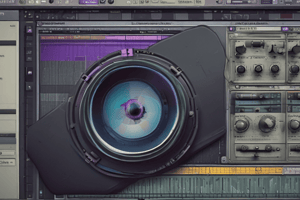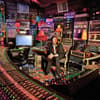Podcast
Questions and Answers
What characteristic defines the frequency response of an audio filter?
What characteristic defines the frequency response of an audio filter?
- The maximum input level
- The amplitude and phase response (correct)
- The total harmonic distortion
- The noise floor reduction
In sound engineering, which aspect of the audio filter is typically prioritized?
In sound engineering, which aspect of the audio filter is typically prioritized?
- The frequency cutoff
- The feedback level
- The phase response
- The amplitude response (correct)
When using a linear time-invariant (LTI) system, what is the output when a sine wave is used as input?
When using a linear time-invariant (LTI) system, what is the output when a sine wave is used as input?
- A square wave with added noise
- A completely flat signal
- A sine wave with potentially different amplitude and phase (correct)
- A distorted waveform
What is a primary advantage of applying reverb and equalization (EQ) through a bus in an LTI system?
What is a primary advantage of applying reverb and equalization (EQ) through a bus in an LTI system?
Which process is involved in obtaining the amplitude response of an audio filter?
Which process is involved in obtaining the amplitude response of an audio filter?
What aspects are important in determining reverb effects?
What aspects are important in determining reverb effects?
Which of the following is a characteristic of amplitude distortion?
Which of the following is a characteristic of amplitude distortion?
What is the primary function of a limiter in audio processing?
What is the primary function of a limiter in audio processing?
Which modulation effect uses a low-frequency oscillator to adjust delay time?
Which modulation effect uses a low-frequency oscillator to adjust delay time?
In convolution reverb, what is used to apply the reverb effect to any sound?
In convolution reverb, what is used to apply the reverb effect to any sound?
What is an example of a condition under which soft clipping occurs?
What is an example of a condition under which soft clipping occurs?
Which of the following parameters does NOT typically affect reverb time?
Which of the following parameters does NOT typically affect reverb time?
What is the effect of a chorus in sound processing?
What is the effect of a chorus in sound processing?
What is the primary purpose of a noise gate in audio processing?
What is the primary purpose of a noise gate in audio processing?
Which compression method is most effective for managing sudden loud sounds?
Which compression method is most effective for managing sudden loud sounds?
What aspect does a reverberation effect primarily alter in a sound?
What aspect does a reverberation effect primarily alter in a sound?
Which technique involves using a compressor to control the dynamic range of multiple frequency bands?
Which technique involves using a compressor to control the dynamic range of multiple frequency bands?
In delay effects, what is the main function of feedback?
In delay effects, what is the main function of feedback?
What is a primary characteristic of a limiter compared to a standard compressor?
What is a primary characteristic of a limiter compared to a standard compressor?
Which parameter is crucial for determining how a compressor affects the signal's dynamic range?
Which parameter is crucial for determining how a compressor affects the signal's dynamic range?
In dynamic range processing, what does a high ratio setting indicate?
In dynamic range processing, what does a high ratio setting indicate?
What does the 'attack time' setting in a compressor control?
What does the 'attack time' setting in a compressor control?
What is a potential effect of using excessive reverb on a sound?
What is a potential effect of using excessive reverb on a sound?
Which type of filter is designed to block specific frequency ranges and allow others to pass?
Which type of filter is designed to block specific frequency ranges and allow others to pass?
What does the quality factor (Q) in a parametric equalizer indicate?
What does the quality factor (Q) in a parametric equalizer indicate?
What role does a dynamic range compressor play in a mixing scenario?
What role does a dynamic range compressor play in a mixing scenario?
In delay effects, which parameter controls how long the original signal is delayed?
In delay effects, which parameter controls how long the original signal is delayed?
Flashcards
Reverb Time
Reverb Time
The time it takes for a sound to decrease by 60dB after the source is silenced.
Convolution Reverb
Convolution Reverb
Applying the impulse response of a room to any sound using a mathematical process.
Flanger Effect
Flanger Effect
A modulation effect that creates a sweeping, whooshing sound using a low-frequency oscillator to modulate a delay.
Chorus Effect
Chorus Effect
Signup and view all the flashcards
Phaser Effect
Phaser Effect
Signup and view all the flashcards
Tremolo Effect
Tremolo Effect
Signup and view all the flashcards
Hard Clipping
Hard Clipping
Signup and view all the flashcards
Harmonic Distortion
Harmonic Distortion
Signup and view all the flashcards
Audio Filter
Audio Filter
Signup and view all the flashcards
Frequency Response
Frequency Response
Signup and view all the flashcards
Amplitude Response
Amplitude Response
Signup and view all the flashcards
Phase Response
Phase Response
Signup and view all the flashcards
LTI System
LTI System
Signup and view all the flashcards
Low-Pass Filter
Low-Pass Filter
Signup and view all the flashcards
Cutoff Frequency
Cutoff Frequency
Signup and view all the flashcards
Slope
Slope
Signup and view all the flashcards
High-Pass Filter
High-Pass Filter
Signup and view all the flashcards
Parametric Equalizer
Parametric Equalizer
Signup and view all the flashcards
Center Frequency
Center Frequency
Signup and view all the flashcards
Quality Factor (Q)
Quality Factor (Q)
Signup and view all the flashcards
Band-Pass Filter
Band-Pass Filter
Signup and view all the flashcards
Bandwidth
Bandwidth
Signup and view all the flashcards
Band-Reject Filter
Band-Reject Filter
Signup and view all the flashcards
Shelving Filter
Shelving Filter
Signup and view all the flashcards
Dynamic Range Processing
Dynamic Range Processing
Signup and view all the flashcards
Envelope
Envelope
Signup and view all the flashcards
Attack
Attack
Signup and view all the flashcards
Decay
Decay
Signup and view all the flashcards
Study Notes
Audio Effects and Signal Processing
- Audio effects alter sound.
- Signal processing modifies audio signals.
- Audio filters (EQ) shape the spectrum of a sound, boosting, attenuating, or removing frequencies.
- A filter's frequency response includes amplitude and phase responses.
- Ideal filters (LTI systems) maintain signal shape, only changing amplitude and phase.
- LTI systems satisfy the equation f(x) + f(y) = f(x + y).
- Filters can be used in a bus to process multiple tracks efficiently.
Audio Filter Types
- Low-pass filter: Allows lower frequencies to pass and attenuates higher ones. Key attributes include cutoff frequency and rate of frequency roll-off (slope, order).
- High-pass filter: Opposite of low-pass, passing high frequencies and attenuating low ones. Key attributes include cutoff frequency and rate of frequency roll-off.
- Parametric equalizer: Allows for precise control of center frequency, amplitude, and quality factor (Q) (inverse relationship with bandwidth), boosting or cutting frequencies.
- Band-pass filter: Passes a specific range of frequencies and attenuates higher and lower frequencies. Identifiable by center frequency, bandwidth (difference between high- and low-cutoff frequencies), and sharpness (quality factor).
- Band-reject (or notch) filter: Attenuates a specific range of frequencies while passing others. Characterized by center frequency, bandwidth, and sharpness.
- Shelving filters (lo-shelf, hi-shelf): Alter the volume of frequencies above or below a cutoff frequency. Key parameters include center frequency and amplitude (boost or cut in decibels) and filter order (slope, 6, 12 dB/octave).
Dynamic Range Processing
- Dynamic range processing modulates signal envelopes.
- Compression: Reduces the difference between loudest and softest sounds. Key parameters include threshold, ratio, attack, release, and makeup gain.
- Knee: Parameter defining how smoothly the compression transition occurs. Hard knee means a sharp transition and soft knee is smooth.
- Implementation: Feed-forward design (Audio In, Amp, Gain reduction, Measure, Audio Out).
- Multi-band compressor: Applies different compression settings to different frequency bands.
- Limiting: A compressor with a high ratio; used to prevent clipping (distortion). Key parameters include threshold, attack, release
- Look-ahead limiter: Anticipates signal spikes and applies compression before they occur
Other Effects
- Noise gate: Removes background noise by reducing volume below a threshold. Key parameters include threshold, attack, and release.
- Expander: Increases dynamic range, making quiet sounds even quieter, inverse of compressor.
- De-esser: Reduces the prominence of sibilant sounds (like 's' or 'th').
- Delay: Adds a time-delayed version of the audio to the original signal, generating comb filtering or echo depending on delay size.
- Reverb: Creates an ambience effect by simulating multiple reflections of a sound source in a space. The reverb effect is distinguished by reverb time, room type (e.g., hall, room, plate), pre-delay, damping.
- Convolution: Applies a convolution effect using impulse response of a physical space.
- Modulation effects (flanger, chorus, phaser, tremolo): Implemented through techniques like modulating delay time with an oscillator.
Distortion
- Amplitude distortion occurs if the output's amplitude isn't a linear function of the input's amplitude.
- Clipping: A form of distortion where the output signal is limited by a threshold. This can occur intentionally in certain sound design applications.
- Harmonic distortion: The output generates harmonics of the input signal's fundamental frequency.
- Intermodulation distortion: Outputs additional sine waves with frequencies that result from sums and differences of input frequencies.
Time/Pitch Shifting
- Modifying the play rate alters pitch.
- Independent time and pitch shifting can create artifacts.
Simulation
- Sound simulation replicates acoustic environments or instruments (e.g., guitar/bass amp, analog distortion pedals, analog delays, vinyl records).
Attribution and Additional Resources
- Images from Wikipedia's Creative Commons Attribution-Share Alike 3.0 Unported license were used.
- Provided study resources include various academic articles and textbooks.
Studying That Suits You
Use AI to generate personalized quizzes and flashcards to suit your learning preferences.





